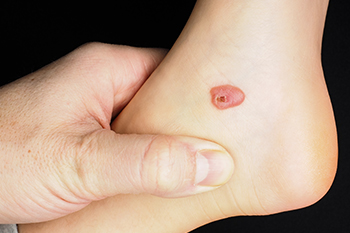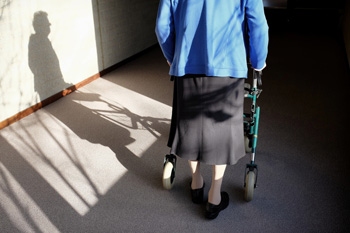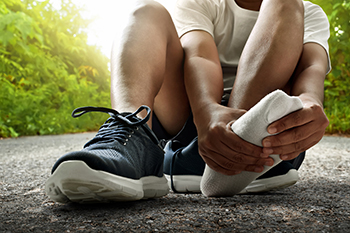Connect With Us
Blog
Items filtered by date: May 2024
Blood Blisters on the Foot

Blood blisters on the foot, though small in size, can cause significant discomfort and concern. These blisters form when blood vessels near the skin's surface rupture due to friction or trauma, trapping blood beneath the skin's layers. Common causes include wearing ill-fitting shoes, repetitive rubbing or pressure, and sudden impacts or injuries. Blood blisters typically appear as raised, fluid-filled sacs with a red or dark appearance due to the presence of blood. While they may resolve on their own over time, treatment options can alleviate pain and promote healing. It is essential to avoid popping or puncturing the blister, as this can increase the risk of infection. Instead, gently clean the area with mild soap and water, apply a sterile bandage or blister pad to protect the blister, and allow it to heal naturally. With proper care and attention, blood blisters on the foot can heal effectively, restoring comfort and mobility. If the blister is painful or shows signs of infection, it is suggested that you consult a chiropodist for further evaluation and management.
Blisters can usually be treated at home, however, if you have recurring blisters or experience significant discomfort or pain, please consult with Paul A. Scotti, D.Ch from West Toronto Foot & Ankle Clinic Inc. . Our chiropodist will assess your condition and provide you with quality foot and ankle treatment.
What Is a Blister?
A blister is a small pocket of fluid in the upper skin layers and is one of the body’s natural responses to injury or pressure. Blisters can also result from burns, fungal or viral skin infections, and the feet are particularly prone due to ill-fitting footwear and friction. Friction on the skin causes the upper layer of skin to separate from the lower layers. The space that this separation creates then becomes filled with a liquid called serum, which protects the lower layers of skin.
Treatment
If you notice a blister on your foot, you can cover it with a soft bandage or dressing to protect it. Popping the blister is discouraged. Doing so exposes the raw skin underneath it to bacteria and also raises the risk of infection. If a blister pops naturally, let it drain before covering it with a bandage. Blisters usually heal on their own or with home treatment, however, if your blister is recurring, very painful, or appears infected, it is recommended that you see a chiropodist for treatment.
Prevention
You can help to prevent blisters by wearing comfortable, well-fitted shoes. Keep your feet dry by wearing moisture-wicking socks and dust your feet with talcum powder if they tend to get sweaty. If you have areas on your feet that are more susceptible to blisters, you might be able to prevent the blister from forming by covering it with a pad.
If you have any questions, please feel free to contact our office located in . We offer the newest diagnostic and treatment technologies for all your foot care needs.
How Seniors Can Better Care for Their Feet

As you age, your feet undergo various changes that require careful attention and proactive care. Seniors can better care for their feet by understanding these changes and adopting healthy habits. With aging, feet may experience the thinning of fat pads, reduced circulation, and diminished flexibility, making them more susceptible to pain, injuries, and conditions like arthritis and diabetes-related foot problems. Regularly examining feet for cuts, sores, or signs of infection is important. Choosing well-fitting shoes with ample support and cushioning helps maintain foot health and prevent discomfort. Keeping toenails trimmed and groomed properly reduces the risk of ingrown nails and infections. Engaging in foot exercises to improve strength, flexibility, and circulation is also beneficial. Moreover, keeping feet dry and wearing clean socks can help prevent fungal infections. If you are a senior, it is suggested that you schedule regular visits with a chiropodist to ensure comprehensive foot care and early detection of any foot issues.
Foot problems can become increasingly common as we age, making everyday foot care especially important. To learn more about maintaining proper foot health, please consult with Paul A. Scotti, D.Ch from West Toronto Foot & Ankle Clinic Inc. . Our chiropodist will assess your condition and provide you with quality foot and ankle treatment.
Common Foot Problems
Certain foot problems may be more likely to affect older adults.
Some examples of foot conditions that can be common in older adults include:
Dry, cracked skin
Calluses and corns
Blisters
Ingrown toenails
Deformities such as bunions or hammertoes
Fungal infections
Plantar warts
Systemic conditions, such as diabetes or arthritis, are also more likely to affect older people and manifest symptoms in the feet and ankles.
Daily Foot Care Tips
Having a daily foot care routine can help detect problems early on and prevent future issues.
Things that you can do at home to care for your feet include:
Washing the feet daily with warm water, drying them thoroughly, and then applying a moisturizer
Trimming the toenails straight across and not too short to prevent ingrown toenails
Performing daily foot exercises to improve foot strength and mobility
Wearing shoes when walking to avoid injury
Inspecting the feet daily for any cuts, scrapes, sores, or other abnormalities and seeking prompt treatment if any problems are discovered
If you have any questions, please feel free to contact our office located in . We offer the newest diagnostic and treatment technologies for all your foot care needs.
Prevention for Running Injuries

Preventing common running injuries begins with understanding the complexity of the feet. With 26 bones, 33 joints, and a network of muscles, tendons, and ligaments, any injury to these structures can disrupt running routines. Feet act as shock absorbers, important for runners who cover substantial distances, making them susceptible to overuse injuries. Common foot injuries like plantar fasciitis, stress fractures, and Achilles tendonitis often occur due to repetitive stress and poor biomechanics. Factors like wearing improper footwear, overtraining, and inadequate stretching can exacerbate these issues. To mitigate the risk of injury, runners should prioritize proper footwear, gradually increase mileage, and incorporate strength training and flexibility exercises into their routines. Regularly assessing and addressing risk factors such as muscle imbalances and biomechanical abnormalities is critical for injury prevention. If you would like personalized advice and treatment regarding running and injuries that can be sustained, it is suggested that you schedule an appointment with a chiropodist for an evaluation and consultation.
Although running is a wonderful exercise to keep you in shape, it can wreak havoc on your feet and ankles if you don’t take preventive measures. If you have sustained a foot and ankle injury from running, please consult with Paul A. Scotti, D.Ch from West Toronto Foot & Ankle Clinic Inc. . Our chiropodist can help you maintain the health of your lower limbs and your mobility.
Some common running injuries include:
Achilles tendonitis
Shin splints
Ankle sprains
Stress fractures
Plantar fasciitis
Bursitis
What causes injuries?
These injuries are usually caused by overtraining, wearing the wrong shoes, running on hard surfaces, having tight and inflexible muscles, or having biomechanical issues in the feet or ankles.
What can I do to prevent injuries?
Train slowly and gradually
Give yourself plenty of time to recover following a run
Wear shoes that fit properly and support your foot
Avoid running on hard surfaces, like concrete
Stretch and strengthen the muscles of your lower legs
Warm-up prior to a run
Have your gait analyzed and your feet examined by a chiropodist to determine if there are any biomechanical problems that need to be treated
If you have any questions, please feel free to contact our office located in . We offer the newest diagnostic and treatment technologies for all your foot care needs.
Arthritis Can Cause Pain in the Feet and Ankles
How Sever’s Disease Affects Children

Sever's disease, also known as calcaneal apophysitis, is a common heel condition primarily affecting active children during periods of rapid growth. It occurs when the growth plate at the back of the heel becomes inflamed due to repetitive stress and tension from activities like running and jumping. This inflammation leads to heel pain, particularly during physical activity or pressure on the heel. To manage Sever's disease, it is essential to rest the affected foot and perform stretching exercises to alleviate tightness in the calf and Achilles tendon. Wearing supportive footwear with cushioning insoles can also help relieve pressure on the heel. If your child has heel pain that persists or worsens, it is suggested that you consult a chiropodist who can provide personalized care, including proper diagnosis, tailored treatment plans, and guidance on activity modification to promote healing and prevent recurrence of symptoms.
Sever’s disease typically affects young children and teenagers. If your child complains of foot pain, please consult with Paul A. Scotti, D.Ch from West Toronto Foot & Ankle Clinic Inc. . Our chiropodist will assess your condition and provide you with quality foot and ankle treatment.
What Is Sever’s Disease?
Sever’s disease, also known as calcaneal apophysitis, is an inflammation of the growth plate in the heel bone. It is typically caused by overuse due to repetitive activities such as running, jumping, and playing certain sports. This condition most frequently affects children between the ages of 8 and 14.
Symptoms
Symptoms of Sever’s disease include:
Pain in the back or bottom of the heel
Pain when the sides of the heel are squeezed
Limping or walking on tiptoes to avoid putting pressure on the heel
Difficulty running, jumping, or participating in usual activities
Fatigue
Diagnosis
Sever’s disease is diagnosed by taking a thorough medical history and performing a physical examination. Imaging studies, such as an X-ray, can help rule out other injuries like a fracture.
Treatment
Sever’s disease typically heals without any long-term complications. Treatment involves resting the affected foot by reducing typical activities, wearing orthotics to support the foot, immobilizing the affected foot, taking medications to reduce pain and inflammation, and stretching the foot.
If you have any questions, please feel free to contact our office located in . We offer the newest diagnostic and treatment technologies for all your foot care needs.
Blog Archives
- April 2025
- March 2025
- February 2025
- January 2025
- December 2024
- November 2024
- October 2024
- September 2024
- August 2024
- July 2024
- June 2024
- May 2024
- April 2024
- March 2024
- February 2024
- January 2024
- December 2023
- November 2023
- October 2023
- September 2023
- August 2023
- July 2023
- June 2023
- May 2023
- April 2023
- March 2023
- February 2023
- January 2023
- December 2022
- November 2022
- October 2022
- September 2022
- August 2022
- July 2022
- June 2022
- May 2022
- April 2022
- March 2022
- February 2022
- January 2022
- December 2021
- November 2021
- October 2021
- September 2021
- August 2021
- July 2021
- June 2021
- May 2021
- April 2021
- February 2021
- January 2021

